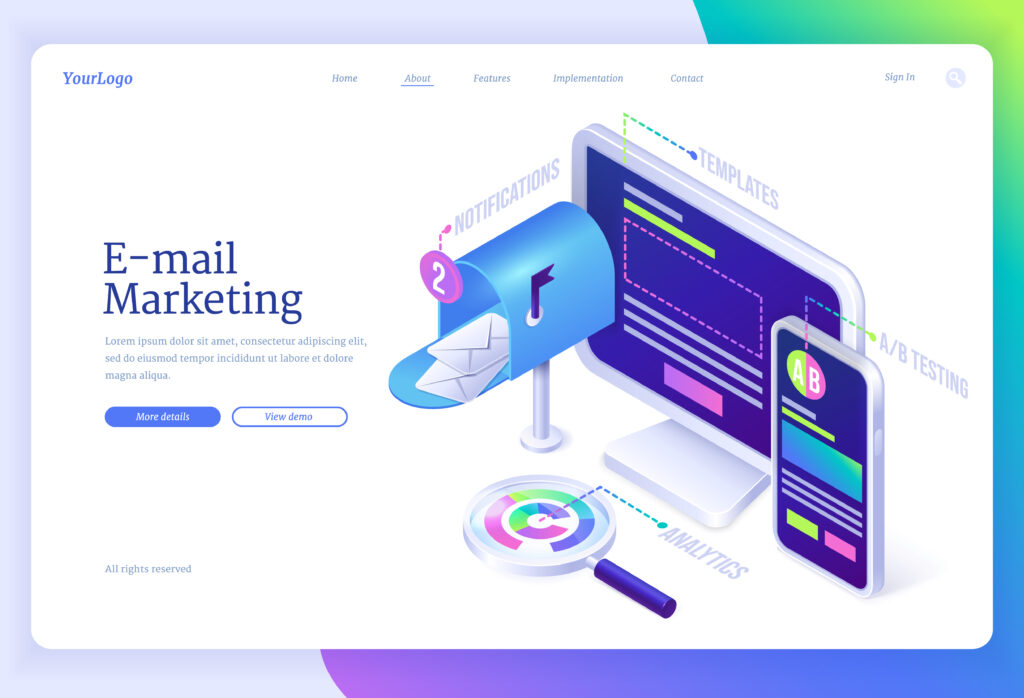Amazing Guide for Small Business With Marketing Strategies That Works!
As a small business owner it can be challenging when it comes to marketing. You often have limited resources and budget constraints, making it crucial to find strategies that deliver results without breaking the bank. Below are a few simple strategies that every business should know about.
1. Know your audience.
To effectively market your small business, you must know your audience inside and out. Understanding who your target customers are and what they need is crucial for crafting compelling marketing messages that resonate with them. So, take the time to research and gather insights about your audience.

Start by creating customer personas or profiles that represent your ideal customers. Consider their demographics, interests, behaviors, and pain points. This will give you a clearer picture of who you're trying to reach.
Additionally, conduct surveys, interviews, or focus groups to gather feedback directly from your existing customers. This will provide valuable insights into their preferences and motivations.
Once you have a deep understanding of your audience, tailor your marketing strategy to speak directly to them. Craft messages that highlight how your products or services can solve their problems or fulfill their needs.
Remember that knowing your audience is an ongoing process. Stay updated with industry trends, customer behavior changes, and evolving market demands to ensure that your marketing strategies remain relevant and effective.
2. Emphasize your value that you small business offers
To effectively market your small business, you need to emphasize your value proposition - the unique benefits or advantages that your products or services offer to customers. Highlight the reasons why someone should choose your business over your competitors.
When promoting your business value and why they should chose you, focus on the specific problems or pain points that your target audience faces and how your service or products can solve them. Clearly communicate the value and benefits that customers will receive by choosing your small business.
Use compelling language and visuals to convey your value proposition in your marketing materials. Whether it's through website copy, social media posts, or advertising campaigns, make sure that your message is clear and easily understandable.
Remember, your value proposition should differentiate you from others in the market. Show what makes you special and emphasize how you provide a better solution or experience for customers.
By emphasizing your unique value proposition, you'll stand out in the market and attract customers who are looking for what you have to offer.
3. Stay focused on one Marketing goal at a time
When it comes to small business marketing, it's important to stay focused on one thing at a time. This means having a clear vision of what you want to achieve and aligning all of your marketing efforts towards that one goal. By staying focused, you avoid spreading yourself too thin and maximize your chances of success.
To start, identify your specific marketing goals. Do you want to increase brand awareness, generate more leads, or boost sales? Whatever it may be, make sure it is a singular goal that you can work towards.
It's a good idea to focus on one marketing channel at a time. For example, if you want to improve your social media marketing, only focus on that for at least 3 months, before thinking of working on your business website for SEO. This will give you a better chance of actually getting it done and building a solid foundation to advertise your business, rather than sporadically doing bits here and there, that may not add value in the end.
Once you have your goal in mind, develop a strategic plan that outlines the steps you need to take to achieve it. This plan should include specific tactics and timelines. By breaking down your goal into smaller, actionable tasks, you'll have a clear roadmap to follow.
Remember to prioritize and stay focused on the most important tasks. Avoid getting distracted by other marketing ideas that may not align with your singular goal. It's easy to get overwhelmed with all the possibilities, but by staying focused, you'll ensure that your efforts are targeted and effective.
4. Use free marketing tools to increase awareness of your business.

To effectively market your small business without breaking the bank, take advantage of free promotional tools. These tools are readily available online and can help you increase your brand visibility and reach a wider audience. Here are some free promotional tools you can use:
- Social Media Platforms: Create business pages on popular social media platforms like Facebook, Instagram, Google Business Profile and Twitter. Use these platforms to share engaging content, interact with your audience, and promote your products or services.
- Online Directories: List your business on online directories such as Google My Business, Yelp, and Yellow Pages. This allows potential customers to find you easily when searching for local businesses in their area.
- Email Marketing: Build an email list of interested prospects and send them regular updates, special offers, and informative content. Use free email marketing tools like Mailchimp or Sendinblue to manage your email campaigns effectively.
- Content Marketing: Create valuable and informative blog posts, videos, or podcasts related to your industry. Share these content pieces on your website and social media platforms to attract and engage potential customers.
- Collaborations: Partner with complementary businesses or influencers in your industry to cross-promote each other's products or services. This helps you tap into their existing audience and gain more exposure for your business.
Remember, using these free promotional tools requires consistent effort and strategic planning. Take the time to research and understand which platforms or tools will be the most effective for promoting your specific business. By utilizing these free resources, you can boost your small business's visibility and attract new customers without spending a dime.
5. Promote yourself on social media.

Social media is a powerful tool for promoting your small business. It's a prime way to promote your business through content marketing by create engaging posts, sharing your products and services, and interacting with your audience. Show off your personality and connect with potential customers in a more informal way. Don't forget to include visuals like photos and videos to grab attention.
Use popular platforms like Facebook, Instagram, and Twitter to reach a wider audience and grow your business. Utilize features like hashtags and tagging to increase your visibility. Engage with your followers by responding to comments and messages promptly.
Create a consistent posting schedule to keep your followers engaged. Share valuable content related to your industry, such as tips, trends, or behind-the-scenes peeks. Use social media to showcase customer testimonials or highlight special offers or discounts.
Remember to be authentic and genuine on social media. Build relationships with your audience by sharing relevant content that aligns with their interests. Use social media analytics tools to track your performance and make data-driven decisions.
Promoting yourself on social media is an effective way to reach new customers and build brand loyalty. So, go ahead, get creative, and let your small business shine in the digital world!
6. Stick to a social media posting schedule.
To effectively market your small business on social media, it's crucial to stick to a posting schedule. Consistency is key in keeping your audience engaged and interested in your content. By establishing a routine, you ensure that your followers know when to expect new updates from you.
Create a schedule that aligns with the optimal times for your target audience. Consider their online habits and when they are most active on social media platforms. This way, you can maximize visibility and reach.
Planning ahead is essential. Decide on the type of content you'll post each day or week. It could be a mix of promotional posts, industry-related tips, behind-the-scenes glimpses, or customer testimonials. Remember to keep it engaging and valuable.
Using scheduling tools like Hootsuite or Buffer can help automate your social media posts. This way, you can focus on other aspects of your business while ensuring consistent and timely content delivery.
Don't forget to interact with your audience by responding promptly to comments, messages, and mentions. Engaging with your followers helps foster a sense of community and builds brand loyalty.
By sticking to a social media posting schedule, you demonstrate professionalism and reliability while keeping your small business at the forefront of your audience's mind.
7. Invest in ads.
Once you have established your small business and are ready to take it to the next level, investing in ads is a smart move. Traditional marketing ads allow you to reach a wider audience and increase brand awareness much quicker than posting organically. Plus, it can drive more traffic to your website or physical store, it's one of the top marketing strategies, and it's a very effective marketing tactic to boost sales.
Paid ads come in various forms, such as search engine ads, social media ads, or display ads on relevant websites. You can choose the platform that aligns best with your target audience and business goals.
By investing in ads, you have the opportunity to specifically target the people most likely to be interested in your products or services. This targeted approach increases the chances of converting potential customers into actual buyers.
Make sure to set a budget for your ad campaigns and closely monitor their performance. This way, you can adjust and optimize your ads based on what works best for your small business.
Remember, investing in ads may require some trial and error before you find the right strategy. Be patient and willing to learn from the data and analytics provided by the ad platforms. With time and persistence, ad investment can yield significant returns for your small business.
8. Make sure you’re capturing web prospects’ information.
One important aspect of small business marketing is to ensure that you're capturing the information of your web prospects. This allows you to stay in touch with them and continue nurturing the relationship.
To capture web prospects' information, you can include a sign-up form on your website where visitors can leave their email addresses. Make sure the form is easy to find and fill out, and consider offering an incentive such as a free resource or exclusive discount in exchange for their contact details.
You can also use pop-up forms or slide-ins to grab attention and encourage visitors to provide their information. Just remember to make these forms unobtrusive and give visitors the option to close them if they're not interested.
Additionally, utilize lead magnets, such as e-books, checklists, or templates, that visitors can download in exchange for their email addresses. This allows you to provide value upfront while building your contact list.
Once you have captured their information, be sure to segment your email list based on relevant factors such as interests or purchase history. This way, you can personalize your emails and provide targeted content that resonates with your prospects.
Remember, capturing web prospects' information is vital for building a strong database of potential customers. By implementing these strategies, you'll be well on your way to growing your small business and increasing your marketing success.
9. Use email marketing to nurture leads.

To effectively nurture your leads, email marketing is an essential tool in your small business marketing arsenal. You can use emails to stay connected with your prospects, build relationships, and ultimately convert them into loyal customers.
Craft engaging and personalized emails that speak directly to your audience's needs and pain points. Remember to keep your emails concise and easy to read, avoiding long paragraphs or jargon. Be friendly, approachable, and authentic in your tone to build rapport with your subscribers.
Segment your email list based on specific criteria such as demographics, interests, or previous interaction with your business. This allows you to tailor your email content according to each segment's preferences and provide targeted offers or promotions.
Provide value with each email by sharing helpful tips, industry insights, or exclusive discounts. By delivering unique content that resonates with subscribers, you'll establish yourself as an authority in their eyes and increase the chances of them choosing your business over competitors.
Lastly, don't forget to track the performance of your email campaigns using analytics tools. Pay attention to open rates, click-through rates, and conversions to optimize your strategies and continuously improve the effectiveness of your email marketing.
By implementing these tips and consistently delivering valuable content through email, you'll nurture leads and move them closer to becoming loyal customers for your small business.
10. Use Lead Magnets to capture lead emails
To capture lead emails effectively, use lead magnets as enticing incentives for your audience. Offer something of value that they can access in exchange for their email address. This could be a free e-book, checklist, template, or exclusive content.
Create visually appealing and informative lead magnets that align with your target audience's interests and needs. Make it clear and compelling what they will gain by providing their email address. Place prominent calls-to-action on your website and landing pages, directing visitors to download the lead magnet.
Once you have their email addresses, you can start nurturing these leads through personalized email campaigns. Deliver valuable content and special offers tailored to their interests based on the lead magnet they downloaded. This helps build trust and moves them closer to becoming paying customers.
Remember to track the performance of your lead magnets by monitoring the conversion rates and measuring the quality of leads captured. Analyze the data to refine your strategy and optimize future lead magnet offerings.
With well-designed and enticing lead magnets, you can capture valuable email leads and establish meaningful connections with your audience.
11. Offer coupons in newsletters or on landing pages.
Offering coupons in newsletters or on landing pages is a great way to attract customers and encourage them to take action. By providing exclusive discounts or promotions, you can entice your audience to make a purchase or engage with your business.
When creating newsletters for your email subscribers, include a coupon code that they can use when making a purchase. This not only incentivizes them to buy from you but also makes them feel valued and appreciated. Be sure to highlight the benefits of using the coupon code and emphasize the limited-time nature of the offer to create a sense of urgency.
Similarly, on your landing pages, incorporate eye-catching banners or pop-ups that display enticing coupon offers. This helps capture the attention of visitors and encourages them to provide their contact information in exchange for the discount.
Remember to regularly update your coupons and tailor them to your target audience's preferences and needs. By offering coupons, you not only drive immediate sales but also build customer loyalty and increase the chances of repeat business.
So start incorporating coupons in your newsletters and on landing pages today, and watch as new customers flock to take advantage of these irresistible deals.
12. Offer a free webinar.
Offering a free webinar is a fantastic way to showcase your expertise and provide valuable information to your audience. With a webinar, you can educate your customers about your products or services while establishing yourself as a trusted authority in your industry.
During the webinar, you can address common pain points or challenges that your target audience faces, providing them with practical solutions and insights. Make sure to choose a topic that will be relevant and engaging for your audience, and offer actionable tips that they can implement in their own businesses.
To promote your free webinar, utilize your social media platforms, email newsletters, and website to spread the word. Create visually appealing graphics or videos to grab attention and entice people to sign up.
During the webinar itself, engage with attendees by encouraging questions and discussion. This interactive format allows you to build relationships and establish yourself as a helpful resource.
At the end of the webinar, offer participants an exclusive discount or bonus related to your products or services. This strategy encourages them to take immediate action and increases the chances of converting them into paying customers.
13. Consider PPC ads with Google & Bing.
If you're looking to reach a wider audience and increase website traffic, consider using pay-per-click (PPC) ads with Google and Bing. These platforms offer a targeted advertising solution that can help you attract more customers who are actively searching for products or services like yours.
With PPC ads, you only pay when someone clicks on your ad, ensuring that you get value for your money. Google Ads and Bing Ads allow you to set your own budget, so you have full control over how much you spend on advertising.
By utilizing PPC ads, you can increase your visibility on search engine results pages and drive qualified leads to your website. These ads appear at the top of the search results, making them highly visible to users.
To get started with PPC ads, you'll need to create compelling ad copy and select relevant keywords that are associated with your business. It's important to continuously optimize your campaigns by monitoring performance metrics and adjusting your strategy accordingly.
14. Try PPC ads on Social Media
Social media platforms like Facebook, Instagram, Twitter, and LinkedIn offer great opportunities for small business marketing. One effective way to leverage these platforms is through pay-per-click (PPC) ads.
By trying PPC ads on social media, you can reach a larger audience and target specific demographics that match your ideal customer profile. These ads can be highly targeted based on factors such as location, age, interests, and behaviors.
With PPC ads on social media, you only pay when someone clicks on your ad or takes a desired action, making it a cost-effective marketing strategy for small business owners on a budget. You can set your own budget and easily monitor your ad performance through the platforms' analytics tools.
To make the most of your PPC ads on social media, focus on creating engaging ad copy and eye-catching visuals that resonate with your target audience. Experiment with different ad formats like images, videos, or carousel ads to see what works best for your business.
Influencer marketing and finding small creators on Instagram to partner with or even other business owners in your community can be a great way to help your business connect with different audiences.
15. Invest in SEO (Search Engine Optimisation)

SEO is the number one online marketing strategy that can bring you a ton of leads organically ( by not using paid ads). Many small businesses rely solely on search engine marketing to help their business grow. SEO involves doing market research to understand which keywords are most relevant in your industry and creating content for your business website or social media accounts.
This often involves creating blogs, videos or anything that your potential customers could search for, this will create interest in your business by organically attracting them to your content. This can help your business grow, as Google will see your website as a reliable source for information and will likely drum up business your way and help customers find your business online.
16. Encourage Happy Customer to leave you a review
To boost their online reputation and attract more customers, small businesses should encourage happy customers to leave reviews. Positive reviews act as social proof and can influence potential customers' decisions.
Small businesses can request reviews from satisfied customers through various channels, such as email newsletters, social media posts, or personal interactions. It's crucial to make the process easy for customers by providing links to review platforms and offering incentives like discounts or freebies in exchange for leaving a review. Additionally, responding promptly to reviews, both positive and negative, shows that the business values customer feedback and is dedicated to addressing any concerns.
Track your marketing Performance and Results
Tracking marketing performance and results is essential for small businesses to measure the effectiveness of their strategies. By utilizing analytics tools and marketing automation, businesses can gain valuable insights into website traffic, user behavior, and conversion rates. These tools provide data on key metrics such as page views, bounce rate, and average session duration. With this information, small businesses can identify which marketing efforts are driving the most engagement and conversions.
17. Track your website with analytics tools.
Through analytics tools, you can monitor key metrics such as page views, bounce rates, and average session duration. These metrics help you understand how users are engaging with your website and identify areas for improvement. For example, if you notice a high bounce rate on certain pages, it may indicate that the content or design needs to be optimized to better engage visitors.
Tracking your website with analytics tools also allows you to identify which marketing efforts are driving the most traffic and conversions. By analyzing referral sources and the effectiveness of different campaigns, you can allocate your marketing budget more effectively and focus on strategies that deliver results.
18. Use pixels for Retargeting
Retargeting is a powerful marketing strategy that allows small businesses to stay top of mind with potential customers who have already shown interest in their products or services. One effective way to implement retargeting is by using pixels.
Pixels are small snippets of code that you can place on your website. When a visitor lands on your site, the pixel places a cookie in their browser, allowing you to track their actions and behaviors. This data can then be used to deliver targeted ads to those visitors as they browse the internet.
By using pixels for retargeting, you can remind past visitors of your brand and encourage them to come back and make a purchase or take another desired action. For example, if someone viewed a specific product or added it to their cart without completing the purchase, you can retarget them with ads featuring that product or offering a discount to entice them to return
Retargeting with pixels also provides valuable insights into consumer behavior. You can track which pages or products are generating the most interest and engagement, allowing you to tailor your marketing efforts accordingly. Additionally, pixels allow you to exclude past customers from seeing certain ads, ensuring that your retargeting efforts are focused on reaching new prospects.
19. A/B Test your Ads and Lead Magnets
If you're a small business A/B testing can be a crucial aspect of any successful marketing campaign, and it applies to both ads and lead magnets. By conducting A/B tests, you can gather valuable insights about what resonates with their target audience and optimize their marketing efforts accordingly.
When it comes to ads and creating a solid marketing plan, running A/B tests involves creating multiple variations of an ad and then testing them against each other to determine which performs better. This can involve tweaking the headline, the call-to-action, the visuals, or any other element of the ad. By comparing the results of these different versions, small businesses can identify which elements are most effective in driving engagement and conversions.
Similarly, A/B testing can also be applied to lead magnets – those valuable resources or incentives that businesses offer in exchange for visitors' contact information. Small businesses can create different versions of their lead magnets, such as different formats or topics, and test them to see which ones generate the highest number of conversions. This allows them to refine their lead magnet strategy and offer content that is truly compelling to their target audience.
20. Consider hiring a Marketing Freelancer or Agency for your online marketing
Between being a small business owner, taking care of accounting, new business, sales and much more, can be overwhelming. Running a small business is not easy and managing marketing initiatives can be time-consuming and often these best practices can take a while to get results. So it's often forgotten, which can lead to a vicious cycle, as you struggle to get new business and market it effectively.
So a good way is to get the help of a freelancer or small marketing agency like WVQ Media to help determine your marketing strategy and also help implement it for you so that you can focus on your own business and at the same time get all the benefits that marketing can bring.
Additionally, working with professionals means getting fresh perspectives and creative ideas. They can offer innovative solutions that you may not have considered before, helping your business stand out in the competitive market.
Conclusion
Ultimately there are a thousand and one ways to market your business, some people rely on giving away their business cards whilst others splash millions on online marketing and billboards. You don't need to implement all of these strategies set here to be successful pick one of three a year to get you started and stick to it! The most important thing is to realise that marketing works and not to give up! It can truly be the difference between having an average to ok business or making it a multi-million dollar venture and I wish that your business will be the latter!
If you are struggling to market your business or you just don't have the time to deal with it hit us up! Check our website out at WVQ Media. We will be more than happy to help you out and make your business a success!



